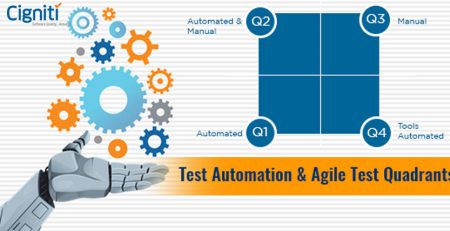Is Your Organization Using The Right Type of Testing Tools?
|
Listen on the go!
|
Quality of software is determined by how well it addresses the customer requirement. It can be software that makes it easy to maintain a website, or software that makes it easier for financial services to comply with regulatory bodies. Quality Assurance (QA) incorporates testing as a continuous process, which requires continuous effort to maintain the standard right from the software development stages, to even after delivery. At each stage, the checking must be done meticulously, because as the software moves further along the application development lifecycle, errors become harder to spot, and if spotted, more expensive and difficult to fix.
For example, when a function is being used when the stack is empty, it would lead to a system crash. In order to avoid this scenario, testing needs to be done in the early stages of development. With software-aided technology seeping into most industries in this digital age, it becomes crucial that corporations produce quality software. Overall, testing is a comprehensive process, and is extremely time taking.
In order to meet deadlines and carry out testing efficiently, testing tools are essential, more so as manual testing often includes a component of unintended human error. Testing tools are often used as part of automated testing, and are essentially programs that specify testing tasks to be performed.
Methods and Types of Testing
Testing tools are built using coding languages such as C and Java. The testing tools provide options while testing, which helps cover the specifics of a certain product. Testing tools can be used as a combination, or individually, according to the testing requirement. The various methods of testing also help determine where testing tools come in handy the most.
- White Box Testing, for example, uses the internal perspective of the system to design its test cases. Resources working with this type of testing must be skilled in programming, in order to be aware of the software architecture. One of the major advantages of this type of testing is that white box tests are easy to automate.
- For Regression Testing, an automated tool environment is a better option as if a failure is caused upon code modification, previous working functions need to be tested for errors.
With different types of testing tools available, it becomes important to understand their functionality and capability. A few such tools have been mentioned below:
- Web tools are used exclusively for web-based applications. Bugs or fixes such as HTML validation or dead links, once identified, are resolved through the tools.
- Security is now a major concern throughout the digital world; and security testing tools are witnessing an increase in demand. These tools can be used to effectively deny access to unauthorized software.
- Performance of a website determines how efficiently a corporation can handle business requests. Performance testing tools help analyze the performance of website servers through load testing, which often struggle or crash under heavy traffic.
- Database testing tools help with creating tables and data to test the database. The tools further help in checking and testing of databases. The SQL DB Validator program, for instance, is a specific database testing tool which helps in validation and verification of a data cube.
The Importance of Choosing the Right Testing Tools
With the availability of a wide range of testing tools, and with the expenses involved in implementing them, it becomes crucial to select the correct one. Corporations intending to use testing tools need to be aware of certain factors to be considered. A few such factors are:
- Organization’s readiness for change. Organizations are constantly looking to grow and expand their empire. It is important that the incoming modifications fit into the current process and help further improve it. Implementation of testing tools would mean that the resources might have to undergo training in order to improve their skillset. Resources accustomed to manual testing would have to work innovatively to automate test scripts and use testing tools effectively.
- Proof-of-concept to cognize whether the product performs as desired and meets the requirements and goals defined for it. An organization looking to implement testing tools would also be looking to eventually alter the internal process to align further with the latest industry norms. For example, an organization transforming its practices from waterfall to agile, would be looking to incorporate shift-left testing, which involves testing right from the development stages. Implementation of testing tools then becomes vital for there to be significant progress over the multiple stages of the application life cycle.
- Choosing suitable test cases and determining the return-on-investment (ROI). Determining the ROI is a key aspect to the commencement of automation testing. While test tools have the capacity to greatly transform the process of testing, they are quite expensive to adopt. If the correct testing tool is not chosen, the framework that comes with the testing tool might not be of much help. In case that happens, the ROI would be minimal, making the implementation of testing tools redundant. Especially while working in the agile method, ROIs are crucial for the profitability of the organization; failing which, the expenses incurred would be hugely disproportionate to the profit gained.
In Conclusion:
Cigniti provides Test automation as one of its core services. Cigniti strongly advocates the need to automate testing software. Innovatively designed test cases can be used to effectively and repeatedly test software at any given stage of the application life cycle. A Quality Engineering approach requires development engineers and Quality Assurance (QA) engineers to work collaboratively.
Cigniti’s test automation framework (CTAF) is a tool-agnostic testing solution for authenticating intricate business processes. CTAF uses a keyword-driven methodology to help non-technical users in validating business processes. CTAF has delivered 30% enhancement in productivity and 40% decline in test maintenance efforts in several test automation engagements. Please visit our website to know more about our testing services.





Comment (1)
[…] requirement takes precedence, and has thus partnered with few leading vendors that provide specific testing tools in order to assure best-of-breed […]